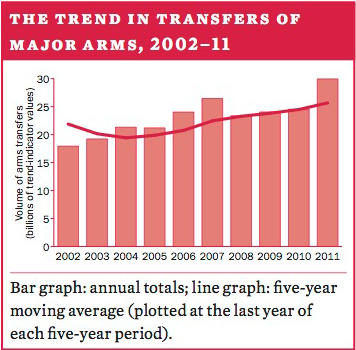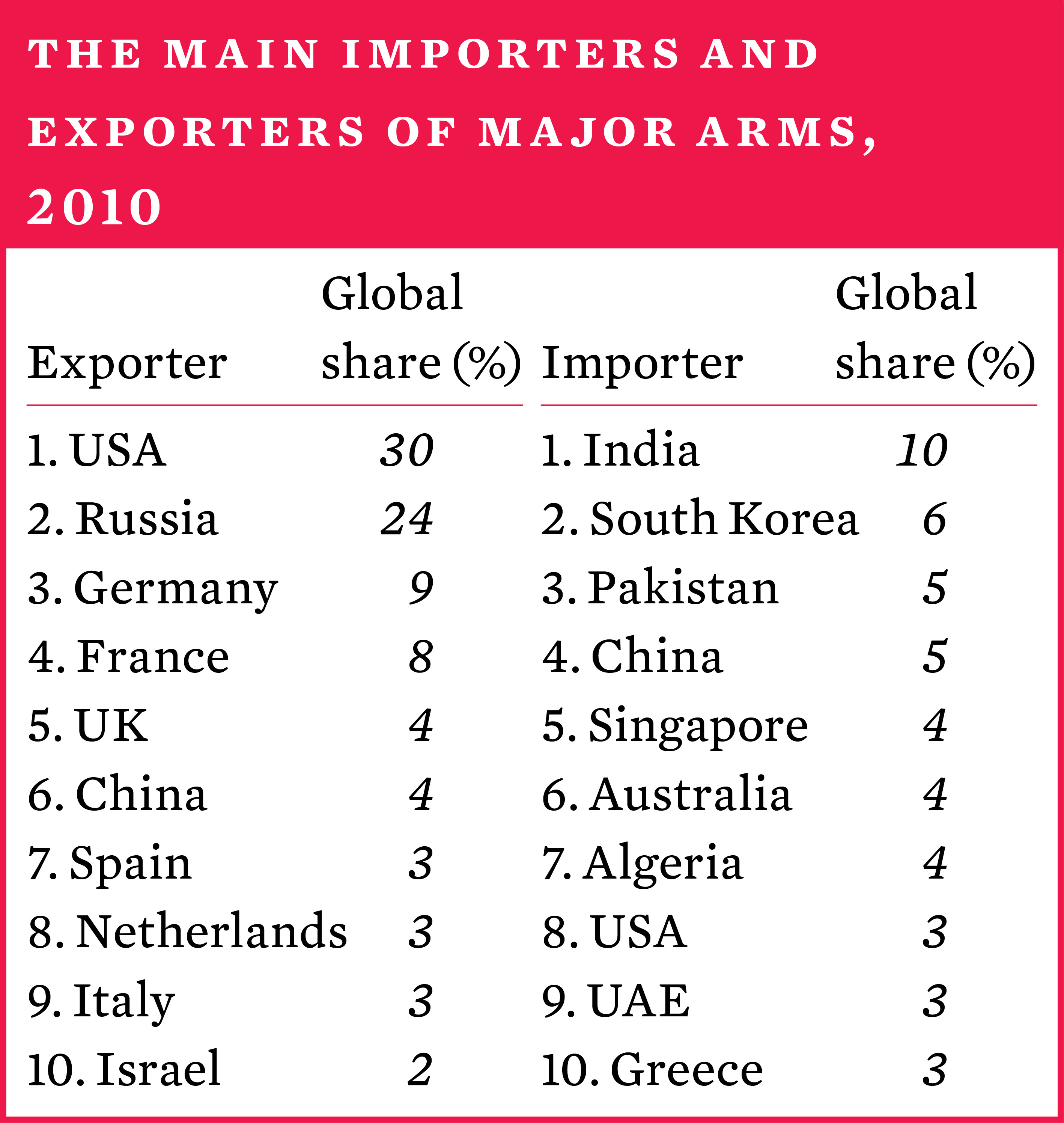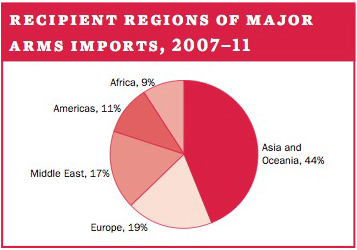6. International arms transfers
Overview, Paul Holtom [PDF]
I. Developments in arms transfers in 2011, Paul Holtom, Mark Bromley, Pieter D. Wezeman and Siemon T. Wezeman [PDF]
II. Policies on exports of arms to states affected by the Arab Spring, Mark Bromley and Pieter D. Wezeman [PDF]
III. The maritime dimension of arms transfers to South East Asia, 2007–11, Siemon T. Wezeman [PDF]
IV. Arms transfers to Armenia and Azerbaijan, 2007–11, Paul Holtom [PDF]
V. Transparency in arms transfers, Paul Holtom and Mark Bromley [PDF]
VI. The financial value of states’ arms exports, 2001–10, Mark Bromley [PDF]
Summary
The volume of international transfers of major conventional weapons grew by 24 per cent between 2002–2006 and 2007–11. The five largest suppliers in 2007–11—the USA, Russia, Germany, France and the UK—accounted for three-quarters of the volume of exports. Outside the five largest arms suppliers, China and Spain recorded significant increases in the volume of deliveries during 2007–11. While China’s exports are likely to continue to grow, Spain’s order book for ships—which account for the bulk of its exports—indicates that it will not maintain its volume of exports.
States in Asia and Oceania received nearly half of all imports of major conventional weapons in 2007–11. Moreover, the five largest recipients of major conventional weapons—India, South Korea, Pakistan, China and Singapore— were all located in the region. Major importers are taking advantage of the competitive arms market to seek attractive deals in terms of financing, offset arrangements and the transfer of technology. India, which received 10 per cent of all imports in 2007–11, is likely to remain the largest recipient of major conventional weapons in the coming years.

The impact of the Arab Spring on arms export policies
The first year of the Arab Spring provoked debate about the policies of major arms suppliers on exports to states in the Middle East and North Africa. Russian officials saw no reason to halt deliveries to any state in the region not subject to a UN arms embargo. In contrast, the USA and several major European suppliers to the region revoked or suspended some export licences to the region and in certain cases undertook reviews of their arms export policies. However, strategic and economic concerns continued to play a central role in all states’ decision-making on arms exports to the region, and the impact of the Arab Spring on arms export policies appears to have been limited.

Arms transfers to South East Asia
The volume of arms transfers to South East Asia increased threefold between 2002–2006 and 2007–11. Naval equipment and aircraft with maritime roles accounted for a significant share of deliveries and outstanding orders by Brunei Darussalam, Indonesia, Malaysia, the Philippines, Singapore and Viet Nam.
Determinants of the types and volumes of weapons sought by these six states include piracy, illegal fishing and terrorism. However, territorial disputes in the South China Sea probably play the most important role in their procurement decisions. This is borne out by defence white papers, the types of weapons acquired in 2007–11 and, in particular, a recent series of low-level maritime confrontations in disputed waters.
States in South East Asia are also making efforts to secure transfers of technology and diversify their sources of supply. Suppliers are increasingly willing to meet the demands of states in the region for extensive technology transfers in arms deals or partnerships to develop new weapon systems.

Transparency in arms transfers
The number of states reporting their arms imports and exports to the United Nations Register of Conventional Arms (UNROCA) increased in 2011 to 85, from an all-time low of 72 states in 2010. There was a notable increase in the Americas, but only one African state reported, the lowest number since UNROCA was created. An increasing number of governments have published national reports on arms exports, including Poland, which published its first reports in 2011.
Arms transfers to Armenia and Azerbaijan
Recent acquisitions, orders and procurement plans by Armenia and Azerbaijan have the potential to increase the risk of renewed conflict over the disputed region of Nagorno-Karabakh. Armenia and Azerbaijan accuse each other of pursuing an arms race.
Azerbaijan has significantly increased its volume of arms imports against a backdrop of bellicose rhetoric on the use of force to settle the conflict over Nagorno-Karabakh. There is limited public information on Armenia’s arms imports in recent years but during 2010 and 2011 it announced plans to procure more advanced weapon systems in connection with Azerbaijan’s procurement drive.
While a voluntary Organization for Security and Co--operation in Europe (OSCE) arms embargo is in force, there are different interpretations of its status by OSCE participating states and arms continue to be supplied to both sides. Russia is a major supplier to both parties. Armenia has a limited range of potential suppliers and is overly reliant on Russia as an arms supplier. In contrast, Azerbaijan has recently concluded significant licensed production arrangements and deals with Israel, South Africa and Turkey as it seeks to use foreign technology to develop an indigenous arms industry.